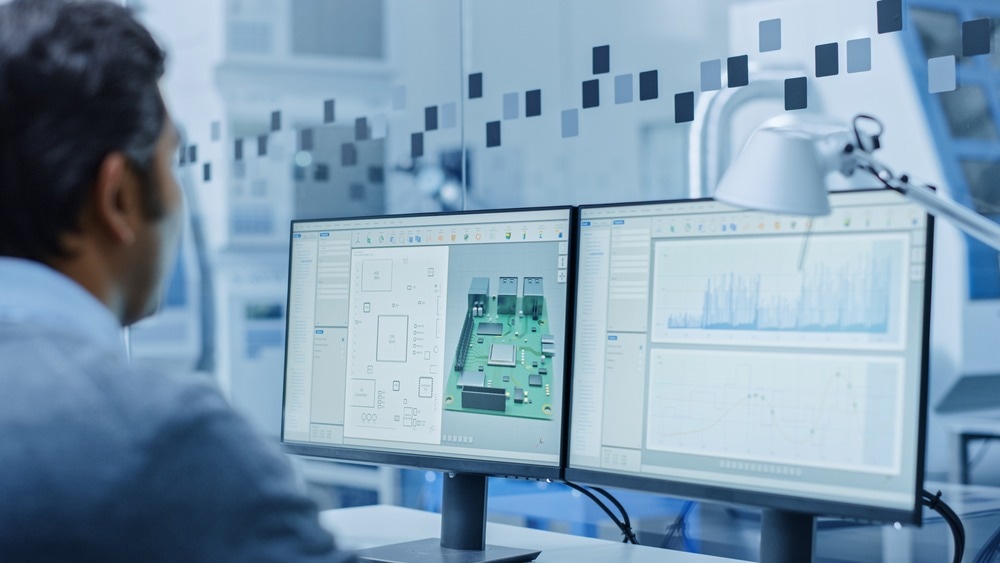Please could you introduce yourself and your role at Cadence?
My name is Mariusz Grabowski, and I am from Krakow, Poland. I work as a Design Engineer II at Cadence Design Systems for the team in Warsaw. We specialize in digital designing and verifying IP cores for cutting-edge SoC (System-on-Chip) architectures. It's a dynamic and innovative field, and I'm excited to be a part of Cadence and contribute to the advancements in semiconductor technology.
Who is Cadence and what are its aims?
Cadence is a pivotal leader in electronic systems design, building upon more than 30 years of computational software expertise. The company applies its underlying Intelligent System Design strategy to deliver software, hardware and IP that turn design concepts into reality. Cadence customers are the world’s most innovative companies, delivering extraordinary electronic products from chips to boards to complete systems for the most dynamic market applications, including hyperscale computing, 5G communications, automotive, mobile, aerospace, consumer, industrial and healthcare.
Cadence customers are the world’s most innovative companies, delivering extraordinary products from chips to systems, chemicals to drugs, and specification to manufacturing for the most dynamic market applications, including hyperscale computing, 5G communications, automotive, mobile, aerospace, consumer, industrial, and life sciences.
We pride ourselves on creating and sustaining a company culture that drives innovation and business success. Cadence is recognized as a Great Place to Work around the world, including as one of the Fortune “100 Best Companies to Work For” over the last nine years.

Image Credit: Gorodenkoff/Shutterstock.com
How did you become involved in this industry? What are some of your main responsibilities in your current position?
I got involved in this industry during my academic years when I developed my first projects in student research groups and my former position at Aldec Inc. as an FPGA design and verification engineer. In this role, I worked in the field of verification for DO-254 compliance and the development of digital processing systems.
I gained valuable hands-on experience in digital design and verification, using hardware description languages (Verilog/SystemVerilog and VHDL), and verification methodologies such as UVM. In addition to my studies and roles, I participated in various industry events, like conferences and competitions.
In my current position as a Design Engineer II at Cadence Design Systems, my main responsibilities revolve around the digital design of IP cores. Working on the project includes, among others, the development of the architecture, RTL design, synthesis, writing specifications and user guides, collaborating with international teams, and ensuring the design meets the highest quality and performance standards.
How does Cadence sit within the semiconductor industry?
Cadence Design Systems plays a pivotal role within the semiconductor industry. With Cadence technology, computational software expertise, and collaboration, our customers turn great ideas into reality faster.
Our company provides a whole suite of tools, software, hardware, IP and services that help these companies design and verify complex semiconductors. We also offer IP cores. These are like the Lego pieces of the semiconductor world. They help our clients build their products faster and with less hassle.
Cadence collaborates closely with semiconductor companies, providing expert guidance at every step of the design process. The goal is to help them tackle challenges and bring their innovative ideas to life. Cadence has a global presence, serving semiconductor and electronics companies worldwide and its solutions are accessible to a diverse range of customers, from startups to industry leaders.
Congratulations on being recognised as part of SEMICON EU’s 20 Under 30. What is this award, and how does it feel to be the recipient as a young professional in this industry?
The SEMICON Europa 20 Under 30 Award program has been established to honor industry’s young leaders who are making significant contributions to the microelectronics supply chain. To be selected as one of the 20 Under 30 recipients in its very first year is incredibly exciting.
It is a remarkable feeling. But more than that, it's a tremendous source of inspiration. It's an industry that embraces fresh ideas and values the contributions of young professionals, which is truly motivating.
Why is it important to recognise the work of young professionals in semiconductor and microelectronics, and how can this benefit the growth of the industry as a whole?
This industry is a rapidly evolving one. Young professionals often bring fresh perspectives, novel ideas, and a hunger for innovation that can drive significant advancements. By acknowledging and celebrating their contributions, we motivate them to excel further and inspire others to pursue careers in this dynamic field.
Furthermore, acknowledging the achievements of young professionals fosters a culture of collaboration and knowledge-sharing within the industry. It encourages experienced professionals to mentor and guide the next generation, facilitating a seamless transfer of expertise and experience.
Cadence specializes in offering support to the electronics industry through AI platforms. Could you discuss some of the company’s highlight AI-enabled platforms?
Cadence offers a comprehensive generative AI solution spanning chip to system to product. It integrates seamlessly with Cadence's existing design tools and platforms, enabling designers to leverage the power of generative AI without disrupting their workflows. The Cadence generative AI solution has been successfully applied in various fields, from drugs to life sciences and from specification to manufacturing.

Image Credit: Richtostock/Shutterstock.com
Are there any challenges that may inhibit the integration of AI in these core industries? How can we improve the perception of AI-enabled software?
In the context of digital design and semiconductor manufacturing, the integration of AI indeed faces certain challenges that need to be addressed. I think complexity and expertise are the crucial ones. Successfully implementing AI requires a deep understanding of AI technologies and the specific industry domain. Finding professionals with the right set of skills can be a hard task.
Also, ensuring that enough relevant data is available and suitable for training AI systems is very challenging, especially in an industry with very strict data privacy regulations. The quantity and quality of data are essential for the success of the AI model.
In my opinion, to improve the perception of AI-enabled software, we should focus on education, collaboration, data management, and community engagement.
What other applications are suitable for Cadence’s solutions besides the semiconductor industry?
While Cadence's solutions are indeed designed with the semiconductor industry in mind, their applications extend far beyond that. It's fascinating to see how these specialized tools and technologies can make an impact in various fields.
In the automotive sector, they assist in designing electronic systems for vehicles, including control systems and infotainment. In aerospace and defense, they are used for avionics, radar systems, and communication equipment. Consumer electronics, such as smartphones and home appliances, also benefit from Cadence's IP cores and design tools.
In the life sciences, Cadence's solutions play a role in diagnostics, medical imaging, and monitoring equipment. Telecommunications equipment, including networking hardware, benefits from Cadence's development tools. In industrial automation, Cadence's solutions aid in designing process control and manufacturing automation systems. The Internet of Things (IoT) leverages Cadence's IP cores for embedded systems in IoT devices and networks.
So, the Cadence impact ripples across various sectors, enabling innovation and advancing technology in countless ways. These diverse applications reflect the adaptability and versatility of Cadence's offerings beyond the semiconductor industry, demonstrating their importance across various sectors and industries.
Cadence recently exhibited at SEMICON EU, forming part of one of the strongest events for electronics manufacturing in Europe. Why was it important to have a presence at this event?
SEMICON Europa is indeed one of the most significant events for electronics manufacturing and a prime platform to showcase the latest technology. For Cadence, this means they can exhibit their cutting-edge electronic design automation (EDA) tools and IP solutions. It's a chance to demonstrate how these solutions can address the ever-evolving needs of electronics manufacturing.
Participating also allows Cadence to establish leadership. Through seminars, presentations, and panel discussions, they can share insights and best practices, contributing to the growth and advancement of electronics manufacturing. Engaging with existing customers is another key benefit. Cadence can use this opportunity to understand their evolving needs, gather feedback, and refine their solutions to meet customer expectations.
Lastly, having a presence at SEMICON Europa enhances Cadence's brand visibility and credibility within the electronics manufacturing community. It reaffirms their commitment to the industry and their role as a trusted partner.
How do you predict the European and broader global semiconductor industry will evolve alongside AI in the coming years?
I think the future of the semiconductor industry presents exciting challenges and opportunities. But, as a digital design engineer, my perspective naturally gravitates towards the digital design and verification aspects of the semiconductor industry.
The demand for more powerful and efficient digital devices continues to grow, driving the need for innovations in digital design. We can predict advancements in design methodologies, tools, and AI support that enable the creation of complex digital circuits with higher performance and lower power consumption.
In the realm of verification, I think AI is going to have an enormous impact. AI-driven verification tools can automate the process of identifying and addressing design issues, improving efficiency and reducing time-to-market.
I believe talent and skills in digital design and verification will continue to be in high demand. Engineers with expertise in AI-driven design and verification tools will be essential to meet the industry's evolving needs.
About Mariusz Grabowski
 Mariusz Grabowski is a Design Engineer II at Cadence Design Systems Inc. in Warsaw. He has both digital design and verification experience. In his current role, he takes part in designing IP cores and is currently working on a PCIe controller project.
Mariusz Grabowski is a Design Engineer II at Cadence Design Systems Inc. in Warsaw. He has both digital design and verification experience. In his current role, he takes part in designing IP cores and is currently working on a PCIe controller project.
His first job was at Aldec Inc., where he worked for two years as an FPGA Design and Verification Engineer in the field of verification for DO-254 compliance and the development of digital processing systems.
Mariusz graduated with a Master's degree with honors in the field of automation and robotics from the AGH University of Science and Technology in Krakow, Poland. During his academic years, he actively participated in the Avader Scientific Group, where he served as a board member, and the Integra Scientific Group.
He participated in numerous events during his scientific career, presenting his papers at conferences (e.g., DASIP 2023) and achieving success in competitions (e.g., 2nd and 3rd place in the international FPGA Hackathon). For his achievements, dedication to work, expertise, and potential to shape the industry’s future, in 2023 Mariusz Grabowski was a recipient of the SEMICON EUROPA 20 Under 30 award, being recognized as a future leader of the microelectronics industry.
Disclaimer: The views expressed here are those of the interviewee and do not necessarily represent the views of AZoM.com Limited (T/A) AZoNetwork, the owner and operator of this website. This disclaimer forms part of the Terms and Conditions of use of this website.